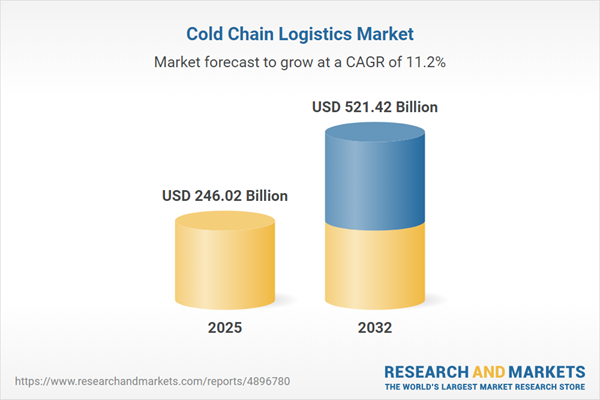Speak directly to the analyst to clarify any post sales queries you may have.
The cold chain logistics market is evolving quickly as organizations face growing complexities in delivering temperature-sensitive goods worldwide. Effective cold chain management is essential for protecting product integrity, complying with regulations, and navigating shifting trade dynamics in an interconnected global landscape.
Market Snapshot: Cold Chain Logistics Market Size and Growth
The Cold Chain Logistics Market grew from USD 222.28 billion in 2024 to USD 246.02 billion in 2025. It is expected to continue growing at a CAGR of 11.24%, reaching USD 521.42 billion by 2032.
This rapid expansion is propelled by advancements in digital monitoring, regulatory changes, and rising demands in sectors ranging from food to pharmaceuticals, underscoring its critical economic impact.Scope & Segmentation
- Service Types: Storage services (cold room storage, warehousing), transportation (air, rail, road, sea), and value-added services (real-time temperature and environmental monitoring, regulatory compliance and documentation management, reverse logistics and returns management, temperature-controlled packaging solutions).
- Temperature Range: Chilled goods (above 0°C) and frozen logistics (below 0°C), with protocols tailored to the demands of each temperature band.
- End-Use: Chemical carriers, food and beverage (including bakery, dairy, frozen foods, meat, seafood), horticulture and floriculture, pharmaceuticals (biopharmaceuticals, vaccines).
- Key Regions: Americas (United States, Canada, Mexico, Brazil, Argentina, Chile, Colombia, Peru), Europe, Middle East & Africa (including United Kingdom, Germany, France, Russia, Italy, Spain, Netherlands, Sweden, Poland, Switzerland, UAE, Saudi Arabia, Qatar, Turkey, Israel, South Africa, Nigeria, Egypt, Kenya), and Asia-Pacific (China, India, Japan, Australia, South Korea, Indonesia, Thailand, Malaysia, Singapore, Taiwan).
- Lead Companies: Inclusive of A.P. Møller - Mærsk A/S, Americold Realty Trust, C.H. Robinson, DHL Group, DSV, FedEx, Kuehne+Nagel, Lineage, United Parcel Service, and others.
Key Takeaways for Senior Decision-Makers
- Digital transformation is redefining temperature control through connected sensors, predictive analytics, and integrated platforms that provide real-time, end-to-end supply chain visibility.
- Strategic diversification in network design—through multi-nodal hubs, nearshoring, and automated storage—boosts resilience and minimizes the risks associated with geopolitical shifts and labor dependencies.
- Sustainability is now a strategic imperative, with major players investing in energy-efficient warehouses, green refrigerants, and alternative power to meet regulatory standards and stakeholder requirements.
- Complexities introduced by regional regulatory changes, including customs protocols and environmental targets, create both compliance challenges and opportunities for operational optimization.
- Customer demand for timely, fresh deliveries is driving innovation in last-mile cold chain solutions, leveraging specialized vehicles and advanced packaging to ensure safe, consistent transit.
Tariff Impact: How 2025 U.S. Tariffs Are Reshaping Cold Chain Logistics
The imposition of cumulative United States tariffs in 2025 has added significant pressure on cold chain logistics by raising the cost of temperature-controlled imports and exports. Stakeholders are adapting by exploring alternate sourcing routes, establishing regional distribution facilities, and leveraging compliance tools integrated with enterprise management systems. These strategies help mitigate additional costs and ensure consistent product quality across borders, while collaborative planning enhances transparency and risk management throughout the complete supply chain.
Methodology & Data Sources
This report employs a blend of primary and secondary research, utilizing interviews with industry executives and specialists alongside analysis of key publications, white papers, and financial filings. Qualitative findings were cross-validated thematically, while quantitative analysis correlated digital infrastructure trends with performance outcomes. Peer review by experts ensures the robustness and neutrality of all interpretations.
Why This Report Matters
- Provides actionable insights to optimize temperature-controlled networks and increase market responsiveness amid new trade and regulatory challenges.
- Enables sector leaders to benchmark digital adoption, sustainability programs, and risk management practices across diverse regions and service models.
Conclusion: Cold Chain Logistics Market Outlook
Dynamic shifts in technology, market segmentation, and regional regulations continue to drive the evolution of cold chain logistics. This report offers essential intelligence to support confident, strategic decisions in managing resilient and future-proof supply chains.
Additional Product Information:
- Purchase of this report includes 1 year online access with quarterly updates.
- This report can be updated on request. Please contact our Customer Experience team using the Ask a Question widget on our website.
Table of Contents
3. Executive Summary
4. Market Overview
7. Cumulative Impact of Artificial Intelligence 2025
Companies Mentioned
The companies profiled in this Cold Chain Logistics market report include:- A.P. Møller - Mærsk A/S
- Americold Realty Trust, Inc.
- C.H. Robinson Worldwide, Inc.
- Cencora, Inc.
- Conestoga Cold Storage Ltd
- Congebec
- Constellation Cold Logistics S.à r.l.
- DHL Group
- DSV A/S
- Emergent Cold LatAm Management LLC
- FedEx Corporation
- FreezPak Logistics
- Frialsa Frigoríficos, S.A. de C.V.
- Green Rabbit by Performance Food Group, Inc.
- GXO Logistics, Inc.
- Interstate Cold Storage, Inc.
- J.B. Hunt Transport Services, Inc.
- Kerry Logistics Network Limited
- Kuehne+Nagel Group
- Lineage, Inc.
- NewCold Coöperatief UA
- Nichirei Logistics Group Inc.
- Orient Overseas (International) Limited
- Prime Inc.
- Ryder System, Inc.
- S.F. Express Co., Ltd.
- Snowman Logistics Limited
- Stevens Transport, Inc.
- Tippmann Group
- United Parcel Service, Inc.
- United States Cold Storage, Inc. by Swire Group
Table Information
| Report Attribute | Details |
|---|---|
| No. of Pages | 197 |
| Published | November 2025 |
| Forecast Period | 2025 - 2032 |
| Estimated Market Value ( USD | $ 246.02 Billion |
| Forecasted Market Value ( USD | $ 521.42 Billion |
| Compound Annual Growth Rate | 11.2% |
| Regions Covered | Global |
| No. of Companies Mentioned | 32 |









